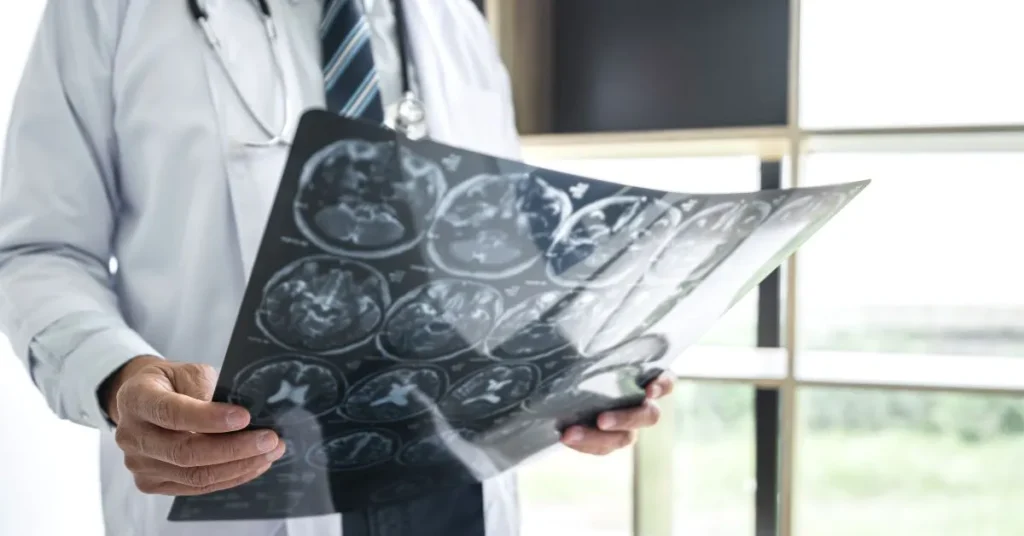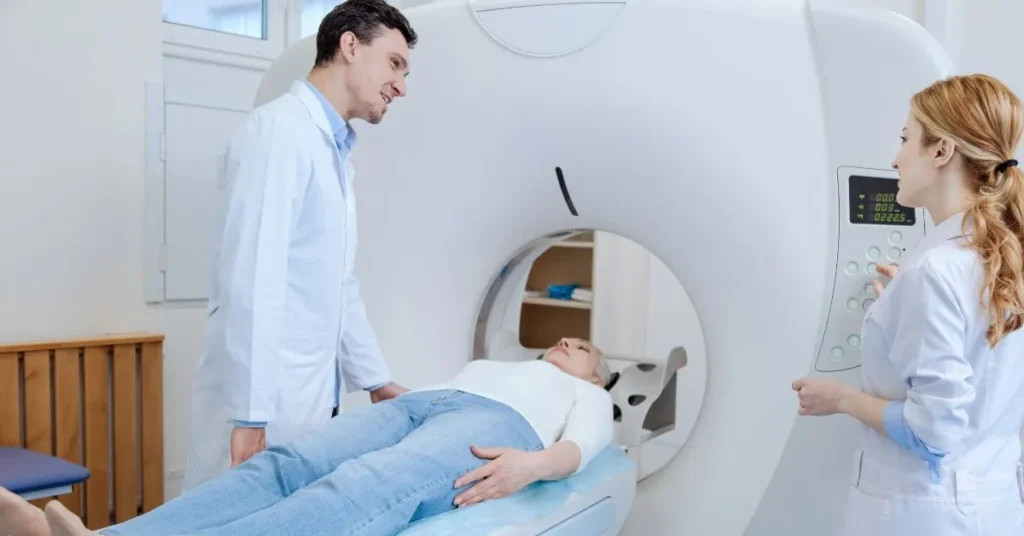fMRI guided-TMS combines functional magnetic resonance imaging (fMRI) with transcranial magnetic stimulation (TMS) to create a powerful treatment approach, especially in the field of mental health. This innovative therapy leverages the precise imaging capabilities of fMRI to map brain activity in real-time. By doing so, it helps identify specific brain regions responsible for various mental health disorders. TMS therapy then targets these areas with magnetic pulses. This precise approach not only enhances the efficacy of the treatment but also minimizes side effects compared to traditional methods.
The significance of fMRI in mental health treatment lies in its ability to provide detailed images of the brain’s functioning. Unlike standard imaging techniques that only capture the structure, fMRI illustrates how different brain parts interact and respond to stimuli. This insight is crucial for understanding the underlying causes of mental health issues. By integrating fMRI in treatments like fMRI guided-TMS therapy, clinicians can tailor interventions more accurately, making it a cornerstone for conditions such as treatment-resistant depression and other complex psychiatric disorders.

Understanding fMRI Guided-TMS Procedure
Basics of Functional Magnetic Resonance Imaging (fMRI)
Functional Magnetic Resonance Imaging, or fMRI, is a non-invasive diagnostic method that measures and maps the brain’s activity by detecting changes associated with blood flow. When a brain area is more active, it consumes more oxygen, and fMRI can detect these changes in blood oxygen levels. This capability makes fMRI an indispensable tool in fMRI guided-TMS because it pinpoints the precise areas of the brain that require stimulation, thereby enhancing the overall effectiveness of the treatment.
Fundamentals of Transcranial Magnetic Stimulation (TMS)
Transcranial Magnetic Stimulation (TMS) is a therapeutic modality that uses magnetic fields to stimulate nerve cells in the brain. It is typically used to treat depression by activating regions of the brain that have decreased activity. When combined with fMRI, the precision of targeting these regions improves significantly. This synergy ensures that TMS therapy for depression not only alleviates symptoms but also contributes to long-term recovery in patients.
How fMRI and TMS Work Together
The collaboration between fMRI and TMS is a fine example of how modern technology can enhance traditional therapeutic techniques. fMRI provides a dynamic map of brain activity, showing which areas are under- or over-active. TMS then uses this map to target specific brain regions with magnetic pulses. This targeted approach helps in modulating the neural activity of the brain, leading to improved therapeutic outcomes in treatments like fMRI guided-TMS for depression and potentially other conditions such as anxiety and PTSD.
Steps Involved in a Typical fMRI Guided-TMS Session
To fully grasp how an fMRI guided-TMS procedure unfolds, it’s essential to understand the sequential steps undertaken during a session. Each phase is meticulously planned to maximize both the safety and efficacy of the treatment.
- Initial fMRI Scan: The session begins with the patient undergoing an fMRI scan. This initial step is crucial as it maps out the brain regions that are either underactive or overactive, pinpointing where stimulation is needed.
- Positioning in the TMS Device: After the areas of interest are identified, the patient is carefully positioned within the TMS device. Proper alignment with the fMRI data ensures that the magnetic coils are accurately placed over the targeted brain regions.
- Alignment of Equipment: The next step involves fine-tuning the equipment settings based on the fMRI results. This precision is key to focusing the magnetic pulses accurately on the areas identified in the scan.
- Administration of Magnetic Pulses: With everything in place, the TMS device delivers magnetic pulses directly to the targeted regions. These pulses are intended to stimulate nerve cells in the brain, adjusting their activity levels to more normal patterns.
- Duration of the Session: Each session typically lasts between 30 to 60 minutes. Patients may require multiple sessions over several weeks or months, depending on their specific medical condition and how they respond to the treatment.
This structured approach in fMRI guided-TMS therapy not only enhances the precision of the treatment but also significantly contributes to its overall success, offering hope and improved outcomes for patients with conditions like depression and anxiety.
Technical Aspects of fMRI Guided-TMS
Equipment Used in fMRI Guided-TMS
The equipment used in fMRI guided-TMS is state-of-the-art, incorporating advanced imaging and stimulation technologies. The fMRI scanner is pivotal, providing real-time brain activity data with high spatial resolution. This data is crucial for pinpointing functional abnormalities related to various mental health disorders. The TMS machine complements this by generating focused magnetic pulses, which are necessary for modulating neuronal activity. Together, these technologies ensure a treatment modality that is both precise and effective.
Process of Mapping Brain Activity
As said before, mapping brain activity through fMRI involves capturing a series of images that reflect cerebral blood flow and neuronal activation patterns. This process is fundamental in the fMRI guided-TMS procedure as it identifies the specific areas of the brain that deviate from normal activity. Such detailed mapping allows clinicians to target the exact locations that will benefit most from magnetic stimulation, thereby enhancing the therapeutic precision needed for effective mental health interventions.
Targeting Specific Brain Regions
Targeting specific brain regions in fMRI guided-TMS therapy involves a meticulous alignment process. The information obtained from the fMRI scans directs the placement of the TMS coils, focusing the magnetic pulses accurately on the identified regions. This targeted approach is crucial for affecting the neural circuits involved in mental health conditions such as depression, anxiety, and PTSD. By concentrating the treatment precisely where it is needed, fMRI guided-TMS optimizes the impact of each session, improving patient outcomes significantly.
Delivering Magnetic Pulses
The delivery of magnetic pulses in fMRI guided-TMS is a critical step that directly influences the efficacy of the treatment. These pulses need to be administered with exact intensity and frequency, which are determined based on the fMRI data. This customization ensures that the magnetic stimulation is both safe and tailored to the individual’s unique brain pattern. It is this personalized approach that sets fMRI guided-TMS apart as an effective depression treatment, offering new hope to those with treatment-resistant conditions.
Benefits of fMRI Guided-TMS
Personalized Treatment Plans
One of the most significant advantages of fMRI guided-TMS is its ability to offer personalized treatment plans. This customization is possible because fMRI provides a detailed map of brain activity, allowing for tailored stimulation based on the individual’s specific neural patterns. By targeting the exact areas of the brain that are malfunctioning, the therapy becomes much more effective, reducing symptoms more significantly than generic treatments. This personalization not only enhances recovery rates but also reduces the likelihood of side effects, making it a highly preferred option for patients and clinicians alike.
Improved Accuracy and Efficacy
The accuracy of fMRI guided-TMS in targeting brain regions is unmatched. This precision results from the integration of real-time fMRI data with TMS technology, ensuring that magnetic pulses are delivered directly to the areas that most need them. Such pinpoint accuracy improves the overall efficacy of the treatment, as it maximizes the therapeutic impact on the intended areas while sparing the surrounding healthy tissue. This methodological precision is especially crucial for treating complex psychiatric disorders, where specific brain regions need to be stimulated without affecting others.
Better Outcomes Compared to Traditional TMS
Compared to traditional TMS methods, fMRI guided-TMS offers significantly better outcomes. Traditional TMS can sometimes be a bit of a blunt tool, lacking the ability to accurately target the necessary brain regions. With the addition of fMRI, clinicians can see exactly where the brain’s abnormalities lie and adjust the TMS treatment accordingly. This leads to a higher success rate in improving symptoms of mental health disorders such as depression, anxiety, and even PTSD, providing a substantial improvement in patient quality of life.
Long-term Benefits for Mental Health
The long-term benefits of fMRI guided-TMS for mental health are profound. Patients often experience sustained improvements in their symptoms, with many achieving remission after completing their treatment course. This enduring effect can be attributed to the therapy’s ability to adjust brain function in a lasting way, potentially re-wiring neural pathways to promote healthier brain activity patterns. Moreover, as a non-invasive and non-pharmacological treatment, it offers a valuable alternative for individuals who have not responded to traditional therapies, including medication.
Effectiveness of fMRI Guided-TMS for Depression
Mechanism of Action for Depression
The mechanism through which fMRI guided-TMS acts to alleviate symptoms of depression involves the modulation of neuronal activity in specific brain regions associated with mood regulation, such as the prefrontal cortex. Depression is often linked to reduced activity in these areas. By targeting them with precise magnetic pulses, fMRI guided-TMS stimulates these regions, promoting increased neuronal activity and rebalancing the brain’s mood circuits. This stimulation helps to elevate mood and alleviate the pervasive feelings of sadness and hopelessness characteristic of depression, offering a new lease on life for many patients.
Clinical Evidence Supporting fMRI Guided-TMS
Clinical trials and studies have shown strong support for the efficacy of fMRI guided-TMS in treating depression. Research indicates that this treatment can significantly reduce symptoms in patients, even those who have not responded to conventional treatments. By leveraging the precise targeting capabilities of fMRI, the therapy ensures that the most affected brain regions receive the necessary stimulation, making the treatment both efficient and effective. This body of evidence continues to grow as more studies confirm the benefits and safety of this advanced therapeutic approach.

Comparison with Other Depression Treatments
The treatment landscape for depression includes various options, each with its own set of benefits and drawbacks. fMRI guided-TMS distinguishes itself in several key areas when compared to more traditional treatments like medication and psychotherapy.
- Medication: Unlike antidepressants, fMRI guided-TMS does not involve pharmaceuticals, thus eliminating the risk of systemic side effects or the need for long-term medication management. This makes it a safer alternative for those concerned about the side effects of drugs.
- Psychotherapy: While psychotherapy is effective over time, fMRI guided-TMS often produces quicker results. This rapid efficacy can be crucial for patients needing immediate relief from severe depression symptoms, providing a quicker return to normalcy and functionality.
- Safety and Effectiveness: fMRI guided-TMS is highly targeted, making it both safe and effective. This precision reduces the risk of unwanted side effects commonly seen with other treatments and increases the likelihood of a positive outcome.
- Scientific Backing: As a newer, technology-based treatment, fMRI guided-TMS is supported by recent clinical research that highlights its effectiveness, particularly for treatment-resistant depression.
These comparisons underline why fMRI guided-TMS is considered an advanced and promising option for treating depression, especially for those who have not had success with traditional methods.
Applications Beyond Depression
TMS Therapy for Anxiety
Transcranial Magnetic Stimulation (TMS) therapy, especially when guided by fMRI, shows promising results not only for depression but also for anxiety disorders. Anxiety, like depression, involves abnormal brain activity, but in regions associated with fear and stress response. fMRI guided-TMS can precisely target these areas, helping to modulate the overactive neural circuits that contribute to anxiety symptoms. Patients undergoing this therapy often report a reduction in their anxiety levels, experiencing a calmer and more balanced emotional state as a result.
TMS Therapy for PTSD
For individuals suffering from Post-Traumatic Stress Disorder (PTSD), fMRI guided-TMS offers a novel therapeutic approach. PTSD is characterized by the brain’s heightened response to triggers that are reminiscent of past traumatic events. By targeting the specific brain regions involved in this disorder, fMRI guided-TMS can help diminish the intensity of the triggered responses, potentially providing a significant reduction in the overall symptoms of PTSD. This treatment helps in rewiring the brain’s response to triggers, offering hope to those who have struggled with conventional treatments.
Research on Other Potential Applications
The potential applications of fMRI guided-TMS extend beyond depression, anxiety, and PTSD. Ongoing research is exploring its efficacy in treating a variety of other neurological and psychiatric conditions, including obsessive-compulsive disorder (OCD), bipolar disorder, and even chronic pain. Each of these conditions involves distinct patterns of brain activity that fMRI can visualize, allowing for targeted TMS treatments that are specifically tailored to the needs of each disorder.
Patient Experiences and Testimonials
The effectiveness of fMRI guided-TMS is further underscored by patient testimonials. Those who have undergone this therapy for various conditions often speak of significant improvements where other treatments had failed. These personal stories not only highlight the therapy’s potential to change lives but also serve as a valuable feedback mechanism for clinicians to refine and improve the approach.
Practical Considerations for fMRI Guided-TMS Therapy
What to Expect During a Clinic Visit
Patients considering fMRI guided-TMS often have questions about what a typical session involves. Upon visiting a TMS therapy clinic, the initial step generally includes a detailed consultation to discuss the patient’s medical history and specific symptoms. The process is initiated with an fMRI scan to precisely identify the areas of the brain that will be targeted during the treatment. During the TMS session, patients will sit in a comfortable chair, and a specialized coil is positioned near the head. While the machine is active, patients may hear clicking sounds and feel a tapping sensation on the scalp, but discomfort is minimal. The session typically lasts between 30 to 60 minutes, during which patients can relax and even listen to music.
Finding a Reputable TMS Therapy Clinic
Selecting a reputable TMS therapy clinic is crucial for ensuring the safety and effectiveness of the treatment. Patients should look for clinics that offer comprehensive diagnostic evaluations, personalized treatment planning, and have experienced, credentialed professionals. It is also beneficial to choose a clinic that maintains robust patient follow-up protocols to monitor progress and make necessary adjustments to the treatment plan. Seeking recommendations from healthcare providers or testimonials from previous patients can also be helpful in making an informed decision.
Insurance Coverage and Treatment Costs
Understanding the financial aspects of fMRI guided-TMS is important for patients. The cost of therapy can vary widely depending on geographic location, the specific clinic, and the number of sessions required. Many insurance companies are beginning to cover TMS therapy, especially when used for conditions like depression which have not responded to traditional treatments. Patients should consult with their insurance providers to understand the coverage details and also explore possible financing options available through the treatment facilities.
Preparing for fMRI Guided-TMS Sessions
Preparation for fMRI guided-TMS sessions involves several steps to ensure the best outcomes. Patients are usually advised to avoid stimulants and to get a good night’s sleep before the session to help keep the brain’s natural rhythms stable. Wearing comfortable clothing and arranging for a friend or family member to drive post-session might be recommended, as some might feel slightly fatigued afterwards. Ensuring all these factors can help make the treatment experience as comfortable and effective as possible.
Throughout this exploration of fMRI guided-TMS, we have delved into the sophisticated interplay between advanced imaging techniques and targeted magnetic stimulation. This therapy stands out due to its precision in diagnosing and treating various mental health disorders. From depression and anxiety to PTSD, fMRI guided-TMS has demonstrated significant potential in improving symptoms where traditional treatments may fall short. Its ability to tailor treatment based on individual brain activity patterns not only enhances efficacy but also minimizes side effects, making it a valuable option for those seeking alternatives to conventional medication and psychotherapy.

fMRI guided-TMS represents a significant advancement in mental health therapy. Its development reflects a broader shift towards personalized medicine, where treatments are increasingly tailored to the unique biological characteristics of each patient. As we continue to witness its success and further explore its capabilities, fMRI guided-TMS stands poised to make a lasting impact on the field of mental health, offering a brighter future for patients and practitioners alike.














